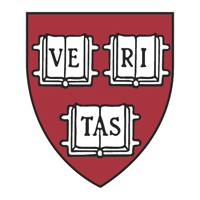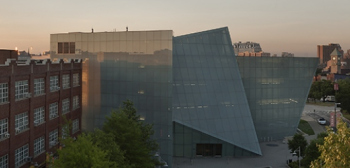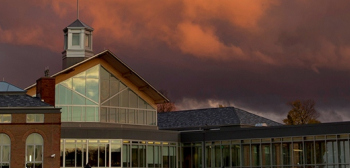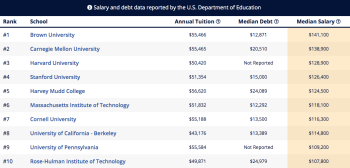哈佛大学
About
The four-year, full-time undergraduate program at Harvard actually makes up a minority of enrolments at the university. Since 2008, undergraduates have completed courses in eight general categories outside their chosen concentration or major. These eight categories are: Aesthetic and Interpretive Understanding, Culture and Belief, Empirical and Mathematical Reasoning, Ethical Reasoning, Science of Living Systems, Science of the Physical Universe, Societies of the World, and United States in the World. Harvard offers 49 concentrations, many of which are interdisciplinary, and there is no predetermined curriculum: students have the flexibility to craft their own in order to meet their own academic goals.
If this sounds like an appealing study environment, be warned that applying to Harvard University is like climbing Everest. Only the strongest succeed. Harvard’s acceptance rate of around 5 percent is the lowest in the United States, a testament to the high caliber of candidates applying to the university. Although Harvard has made significant efforts to be meritocratic in its admissions process, like other Ivy League institutions it offers legacy preferences to children of alumni, a policy which has been criticized for favoring wealthy white applicants. An early admission program is also operated by Harvard, having been reintroduced in 2011.
Applications can be submitted through the Common Application, Coalition Application, or Universal College Application. No one method of application is given preference by the university. The application includes the form and essay question answers; two teacher evaluations; a secondary school report including transcripts and a mid-year school report; as well as two SAT subject tests and an ACT test or writing component. The application fee is a standard US$75.
Around 12 percent of the latest undergraduate intake were from international backgrounds, and international students go through exactly the same admissions process as American students. English language proficiency test marks can be submitted but are not obligatory. International candidates are, however, strongly encouraged to attend an interview.
The annual cost of an undergraduate education at Harvard is US$73,600, inclusive of tuition, fees, room, board, personal expenses, and travel costs. It’s no small outlay, but Harvard University does offer need-based finance planning for families at all income levels, something which is taken up by 70 percent of its students. This can include scholarship funds, jobs on campus or student loans. As a result, 100 percent of students are able to graduate from Harvard debt-free, and 20 percent of students’ families pay nothing.
About
The four-year, full-time undergraduate program at Harvard actually makes up a minority of enrolments at the university. Since 2008, undergraduates have completed courses in eight general categories outside their chosen concentration or major. These eight categories are: Aesthetic and Interpretive Understanding, Culture and Belief, Empirical and Mathematical Reasoning, Ethical Reasoning, Science of Living Systems, Science of the Physical Universe, Societies of the World, and United States in the World. Harvard offers 49 concentrations, many of which are interdisciplinary, and there is no predetermined curriculum: students have the flexibility to craft their own in order to meet their own academic goals.
If this sounds like an appealing study environment, be warned that applying to Harvard University is like climbing Everest. Only the strongest succeed. Harvard’s acceptance rate of around 5 percent is the lowest in the United States, a testament to the high caliber of candidates applying to the university. Although Harvard has made significant efforts to be meritocratic in its admissions process, like other Ivy League institutions it offers legacy preferences to children of alumni, a policy which has been criticized for favoring wealthy white applicants. An early admission program is also operated by Harvard, having been reintroduced in 2011.
Applications can be submitted through the Common Application, Coalition Application, or Universal College Application. No one method of application is given preference by the university. The application includes the form and essay question answers; two teacher evaluations; a secondary school report including transcripts and a mid-year school report; as well as two SAT subject tests and an ACT test or writing component. The application fee is a standard US$75.
Around 12 percent of the latest undergraduate intake were from international backgrounds, and international students go through exactly the same admissions process as American students. English language proficiency test marks can be submitted but are not obligatory. International candidates are, however, strongly encouraged to attend an interview.
The annual cost of an undergraduate education at Harvard is US$73,600, inclusive of tuition, fees, room, board, personal expenses, and travel costs. It’s no small outlay, but Harvard University does offer need-based finance planning for families at all income levels, something which is taken up by 70 percent of its students. This can include scholarship funds, jobs on campus or student loans. As a result, 100 percent of students are able to graduate from Harvard debt-free, and 20 percent of students’ families pay nothing.
University highlights
- 2012#3
- 2014#2
- 2015#4
- 2016#2
- 2017#3
- 2018#3
- 2019#3
- 2020#3
- 2021#3
- 2022#5
- 2023#5
- 2024#4
- 2025#4
- 2026#5
Campus locations
Harvard University,
1350 Massachusetts Avenue , Cambridge , Massachusetts , United States , 02138
651 Huntington Avenue,
651 Huntington Avenue , Boston , Massachusetts , United States , 2115
324 North Main Street,
324 North Main Street , Petersham , Massachusetts , United States , 1366
Similar Universities
乔治华盛顿大学商学院
George Washington University, Washington D.C.
马里兰州立大学艺术学院
1300 W. Mount Royal Avenue, Baltimore
德克萨斯大学阿灵顿大学
701 S. Nedderman Drive, Arlington
萨凡纳艺术与设计学院
516 Drayton St, Savannah
Seton Hall University
400 S Orange Ave, South Orange, South Orange
罗彻斯特理工大学 (RIT)
Lomb Memorial Drive, Rochester
























